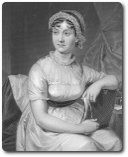Tess of the d'Urbervilles Contents
Plot structures
Characters
 The structure of Tess of the d'Urbervilles regarding the relationships of characters with one another is akin to that of a Jane Austen novel, where a heroine is courted by two suitors, one good, one bad. The good one may appear bad at times and the bad appear good. The heroine's growth is in distinguishing reality from pretence. Jane Austen's method and tone is ironic, exposing what is false and pretentious.
The structure of Tess of the d'Urbervilles regarding the relationships of characters with one another is akin to that of a Jane Austen novel, where a heroine is courted by two suitors, one good, one bad. The good one may appear bad at times and the bad appear good. The heroine's growth is in distinguishing reality from pretence. Jane Austen's method and tone is ironic, exposing what is false and pretentious.
More on character structure in Victorian novels: This structure is followed by quite a number of Victorian novelists, with variations. For example, in George Eliot's Mill on the Floss, Maggie fails to recognise the right suitor, although the wrong man is not immoral, only shallow.
- Hardy's Tess is discerning, as she can immediately sense the good suitor from the bad, even though her family cannot. Initially, she doesn't quite know why Alec is bad, but she soon finds out
- Unlike Austen's romances, where the heroine finds out in time, in Hardy's more tragic novels, it is usually too late
- The twist in Tess is that the ‘good' suitor turns out not to be so good after all, and, might be said to be worse than the ‘bad' one. By the time Angel repents and has moral insight, it is too late
- Interestingly, in Tess, the two suitors never actually meet, though they come to know about each other. One exits as the other makes an entrance in Tess's life.
Such plots are very economical of characters. Thomas Hardy uses the minor characters to build up various communities, which may be compared to each other, and to show how the heroine is affected by them.
Acts of violence
Another structure can be based on the three central acts of violence:
- Tess's rape / violation
- Angel's abandonment of Tess
- Alec's murder.
One act leads to another by a train of internal logic within Tess herself. The final, undemonstrated act of violence, that of Tess's hanging, follows inexorably according to the external forces of justice. Thus, from Ch 1 to Ch 59 there is a causality and sequence established by the narrative, which could be described as ironic since what happens is usually the opposite of what characters actually desire. There is a further irony in that Tess unwittingly re-enters the world of the ancestral d'Urbervilles, who are depicted as men of violence. She becomes both victim and perpetrator of this violence, which is still being re-enacted, seemingly in a way determined by the past, even though Tess disavows it (see Patterns of the past).
Recently Viewed
-
Tess of the d'Urbervilles » Plot structures
now -
A-Z: General definitions » Narrative arc
just now -
A-Z: General definitions » Fate
just now -
Tess of the d'Urbervilles » Timeline
just now -
Tess of the d'Urbervilles » Images
just now -
Tess of the d'Urbervilles » Becoming a novelist
just now -
Tess of the d'Urbervilles » Chapter 57
just now -
Tess of the d'Urbervilles » Chapter 55
just now -
Tess of the d'Urbervilles » Chapter 51
just now -
Tess of the d'Urbervilles » Chapter 46
just now -
Tess of the d'Urbervilles » Chapter 41
just now -
Tess of the d'Urbervilles » Chapter 40
just now -
Tess of the d'Urbervilles » Chapter 38
1 minute ago -
Tess of the d'Urbervilles » Chapter 37
1 minute ago -
Tess of the d'Urbervilles » Chapter 27
1 minute ago -
Tess of the d'Urbervilles » Chapter 20
1 minute ago -
Tess of the d'Urbervilles » Chapter 15
1 minute ago -
Tess of the d'Urbervilles » Chapter 6
1 minute ago -
Tess of the d'Urbervilles » Chapter 4
1 minute ago -
Tess of the d'Urbervilles » Films and DVDs
1 minute ago -
Tess of the d'Urbervilles » What makes a good English exam answer
2 minutes ago -
Tess of the d'Urbervilles » Engaging with the text
2 minutes ago -
Tess of the d'Urbervilles » Romantic pespectives
2 minutes ago -
Tess of the d'Urbervilles » Time structures
2 minutes ago -
Tess of the d'Urbervilles » Moral patterns
3 minutes ago
Scan and go
Scan on your mobile for direct link.